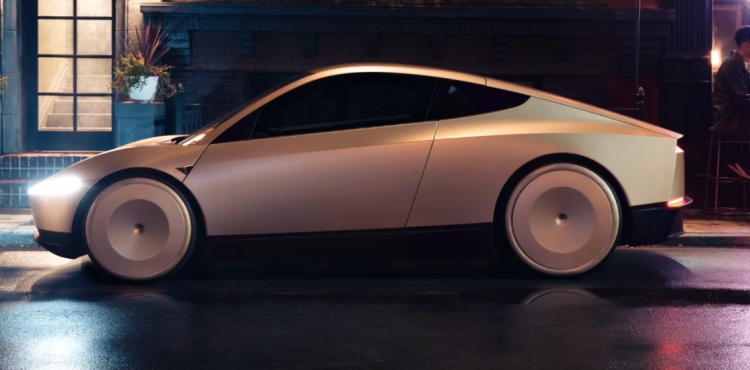Tesla CEO Elon Musk unveiled the highly anticipated Cybercab robotaxi at the "We, Robot" event in Los Angeles on Thursday night, marking a significant step in the company's autonomous vehicle strategy. Amid a spectacle that featured Tesla's humanoid robots serving drinks and dancing for the crowd, Musk also surprised attendees with the introduction of a larger autonomous vehicle, the Robovan, designed to transport up to 20 passengers or large amounts of cargo.
Musk's dramatic arrival at Warner Bros Studios in Burbank via the Cybercab set the tone for an evening that mixed high-tech aspirations with bold promises. The Cybercab, a sleek vehicle with scissor-like doors, a minimalist interior, and no steering wheel or pedals, embodies Tesla's vision for a future dominated by fully autonomous transportation. "We'll move from supervised full self-driving to unsupervised full self-driving," Musk said, emphasizing that Tesla's latest technology will eventually eliminate the need for human intervention.
Priced at under $30,000 and expected to hit the market between 2026 and 2027, the Cybercab aims to be a more affordable option in the autonomous vehicle space. However, industry analysts remain skeptical about Tesla's ability to deliver on this promise. Paul Miller, an analyst from Forrester, questioned the feasibility of Tesla's price point, stating, "It will be extremely difficult for Tesla to offer a new vehicle at that price within that timescale. Without external subsidies or making a loss on every vehicle, it doesn't seem plausible."
The Cybercab isn't just a conceptual vehicle; it represents a crucial element in Tesla's plan to disrupt the rideshare market. By integrating full self-driving capabilities with Tesla's upcoming rideshare mobility app, the company envisions existing Tesla owners being able to rent out their vehicles when not in use, creating a new source of income for drivers. Wall Street analysts see this development as a potential game-changer, estimating that it could unlock significant value for Tesla and its customers.
In a surprise twist, Musk also revealed the Robovan, a larger autonomous EV with a design reminiscent of a science fiction movie, featuring hidden wheels and a futuristic facade. The Robovan is engineered to transport up to 20 people, making it adaptable for commercial or personal use. While no specific timeline or pricing was provided for the Robovan, Musk hinted that it could serve as a versatile transportation option in the coming years.
Despite the buzz surrounding these announcements, Tesla's stock fell more than 5% in premarket trading on Friday, reflecting investor concerns about the company's ambitious timelines and the feasibility of achieving true full autonomy. Analysts and experts have long expressed doubts about Tesla's aggressive promises in the self-driving arena, especially given the challenges other companies face in securing regulatory approval for similar technologies.
Safety remains a significant hurdle for Tesla's autonomous ambitions. The company's approach relies heavily on camera-based systems instead of more expensive radar or Lidar technology, a method that has drawn skepticism from industry experts. "It's a big chunk of metal driving on roads at high speeds, so safety concerns are big," said Samitha Samaranayake, an associate professor in engineering at Cornell University. He noted that while Tesla's data-driven AI approach is innovative, it does not yet provide the safety guarantees required for widespread adoption.
Tesla plans to begin unsupervised full self-driving trials with its Model 3 and Model Y vehicles in Texas and California next year, pending regulatory approval. Musk acknowledged the uncertainty around the timeline, admitting, "I tend to be optimistic with time frames." The comment reflects Musk's track record of setting ambitious goals that are often delayed, raising questions about whether the Cybercab and Robovan will indeed hit the market within the projected window.
The competitive landscape for autonomous vehicles is heating up, with companies like Waymo, Cruise, and Baidu pushing their own robotaxi technologies. General Motors' subsidiary Cruise has already deployed driverless cars in several U.S. cities, although it recently faced setbacks when one of its vehicles was involved in an accident in San Francisco. Waymo continues to expand its fleet, recently integrating the Hyundai Ioniq 5 into its lineup, while Uber announced a multi-year alliance with Cruise to bolster its ridesharing options.
Despite Tesla's elaborate presentation and bold claims, the path to widespread adoption of autonomous vehicles remains fraught with challenges. Musk's vision of a fully self-driving future hinges on overcoming regulatory, technological, and safety barriers that have stymied many competitors in the field. Jessica Caldwell, head of insights at Edmunds, summed up the sentiment by saying, "Musk did a fantastic job of painting an ideal future for transportation that promises to both free up our time and increase safety, but many questions remain about how this will be achieved from a practical standpoint."






